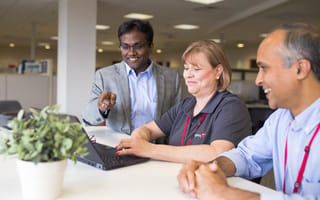We recently caught up with three Agero engineers who are combining rich data sets with the cloud to ensure that the 80 million drivers their company serves each year stay safe.
By maintaining the infrastructure behind the company’s platform, they’re helping make Agero the leading provider of driving solutions – including roadside assistance – in North America.



FOUNDED: 1972
WHAT THEY DO: Transform the driving experience through a combination of innovative technology and human-powered solutions, including breakthrough mobile apps, telematics and accident management solutions designed to bring added safety and convenience to drivers everywhere.
EMPLOYEES: 460 (Medford, Mass.); 2,855 (National)
PERKS: Free roadside assistance and company-matching 401(k)


Karen Hutchinson, Director of DevOps, Agero
As the Director of DevOps at Agero, Karen Hutchinson is responsible for the successful lift/shift and microservice deployment of multiple data center applications into AWS. She also built a site reliability team to monitor, alert and prevent application and infrastructure issues. This included the creation of a 24/7 offshore level one escalation team.
Additionally, Karen builds DevOps automation into the software engineering process by using automated pipelines, Agile process tooling, GIT implementation and microservices. She’s helped transform a data center IT organization into a cloud engineering service team. The team offers service catalogs to AWS-based software developers, building security and financial guardrails for the company.
BEYOND WORK: Karen loves dogs — especially obedience training and dog showings. Her Rhodesian Ridgebacks have won grand championships in the show ring. She even volunteers at the local shelter.
Describe what your team is responsible for doing. What problems are you solving?
My team is responsible for the data centers Agero software products run in. It’s pretty exciting. Right now, we’re in the process of moving the applications from the data centers to the AWS cloud. This requires re-architecting the product and our infrastructure, as well as re-skilling the team in AWS technology.
We’re also responsible for automating the deployment process and transforming the software development process to a “shift left” and fully-automated mindset. I also field a team responsible for monitoring the AWS infrastructure to find and resolve issues before our internal users experience a problem with the app.
Describe an ideal candidate for this team. Who makes a good “culture fit”?
Someone very comfortable working in AWS, with a good knowledge of monitoring tools and a full-stack mindset. Full-stack means that they have UI, database, middleware and API knowledge. We’re not looking for an expert in any one of those areas – but rather someone with general knowledge in all of those areas.
Describe your company’s approach to training engineers in general. Does the company emphasize it? How?
When Agero put plans into place to move from data centers to the AWS cloud, an online training package was purchased to build up the team’s AWS skills. In the past year, we’ve put approximately 100 people through this training. More than half of them went on to obtain their AWS Architect certification and another 25 went on to obtain multiple certifications.
Instead of hiring a team of AWS experts, we trusted the talents of Agero’s existing team and helped them come up-to-speed to do the job. We completed the move to AWS in only one year, and it’s awesome how the expertise and experience of the team continues to grow.
Reflect back on when you joined this company. Is there anything about this job that surprised you?
I love that Agero is a family-owned business; the original owner still walks the halls from time to time. There’s a real feeling of belonging here as a result and a sense that Agero is not just a business, but an extended family where we come together to be successful. Another aspect is the sense of urgency and empathy for the stranded customers who call us “stuck on the side of the road”.
It’s great to help people every day. The need to ensure their safety — as well as to resolve their issue — permeates all of Agero from the call center agents right through to the engineering and product management teams.
It’s great to help people every day. The need to ensure their safety permeates Agero."
If a developer came to you and said they were burnt out, what would you say or do?
First, I would tell them to take three comp days to do nothing but lay on the couch and watch “I Love Lucy”! Second, I’d find a way to transfer their knowledge, and offload their work, to another team member.
And because I’m much more interested in building teams that work well together than having a few heroes, I would discuss with them their specific goals. This would ensure that they can offload their work, learn a new skill and help train multiple people to handle the workload that was burning them out.


Sunil Gupta, Software Engineering Manager
As a Software Engineering Manager, Sunil Gupta tries to shield his team from diversions, allowing them to stay focused on the engineering backlog. Agero has many moving parts, and Sunil encourages every team member to work outside their comfort zone and challenge the status quo to optimize platform design.
BEYOND WORK: Sunil volunteers with a parent-run nonprofit organization at his daughter’s school. The organization’s mission is to build and maintain a community of parents and guardians in support of the school’s student activities.
What's your tech stack and methodology? Why do these work for you?
Our tech stack in the core engineering team is primarily .NET, and we practice Scrum because it allows us to promote a team mindset in delivering business value. A team mindset is something we value highly.
We know every day is different. But, generally speaking, how does your day break up?
I spend time in meetings and planning activities for the team backlog. I also spend a lot of time doing whatever I can to allow my team to stay on task. Saying “no” is a challenge for many. But I keep reiterating that, unless we have a production issue, it’s okay to say “no” if it means we can stay committed to the team goal.
What is the breakdown of a developer's day? What’s unique about it?
Most of the time is spent designing and coding. A good bit of time is also spent in requirements analysis and in troubleshooting together as needed. And then — there is foosball!
If you look at what this team has achieved so far, what are you proudest of?
I’ve been with Agero for about four months, and I’ve noted significant differences in the team dynamics. We just started using HD cameras for all of our Scrum meetings since we’re all in different locations. The team members now feel more connected to one another with a greater sense of ownership of the product they are working on. I like that.
I was surprised by the number and the complexity of the moving parts that go into supporting Agero’s roadside assistance program."
Reflect back on when you joined this company. Is there anything about this job that surprised you?
I was surprised by the number and the complexity of the moving parts that go into supporting Agero’s roadside assistance program, and also by the impressive mix of current technologies that the engineering teams use here.


Karuth Sanker, VP Engineering / Architecture
Karuth Sanker plays a key role in transforming Agero’s technology into business outcomes. Karuth creates technology roadmaps for the company’s business strategy and then helps the team execute the vision.
BEYOND WORK: Karuth has a deep passion for yoga. In fact, he would someday like to practice yoga in a cave in the Himalayas. Yoga and meditation help him realize his true potential and understand the world from different dimensions.
What is your team responsible for doing?
My team is great. They create an Uber-like experience for the tow industry with a sub-second latency multi-sided platform. At peak, we service 3,000 concurrent customers simultaneously. Our platform is built in AWS cloud, true Polyglot Microservices architecture, Elastic Search, MongoDB, Splunk machine learning, Poly, Dynamo, Various RDS, Angular, Vue apps from Alexa to basic IVR integration, mobile app, desktop app and Twilio. In short, we’re a company that uses very cool technology to solve real-life problems.
We’re a company that uses very cool technology to solve real-life problems."
When interviewing, how do you know you’ve found the right candidate? Who makes a good “culture fit”?
An engineer who has learned with real-world software, has built applications with complex integration, and has the ability to learn and keep up with the pace of AWS technology. My ideal candidate has a strong background in computer fundamentals, likes to read code and contribute to open source.





